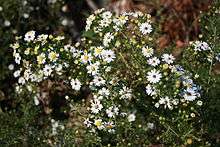Symphyotrichum ericoides
| Heath aster | |
|---|---|
 | |
| Scientific classification | |
| Kingdom: | Plantae |
| (unranked): | Angiosperms |
| (unranked): | Eudicots |
| (unranked): | Asterids |
| Order: | Asterales |
| Family: | Compositae |
| Tribe: | Astereae |
| Genus: | Symphyotrichum |
| Subgenus: | Symphyotrichum |
| Section: | Symphyotrichum |
| Species: | S. ericoides |
| Binomial name | |
| Symphyotrichum ericoides (L.) G.L.Nesom | |
Symphyotrichum ericoides, syn. Aster ericoides (common name white heath aster,[2] white aster or heath aster), is a species of flowering plant in the family Asteraceae, native to much of North America, as well as northern Mexico. It has also been introduced to many areas beyond its native range.
Description
Heath aster is an herbaceous perennial with stems from 1 to 3 ft (0.30 to 0.91 m) tall.[3] Its leaves are sessile (stalkless) and narrow, and become smaller towards the end of the stems and branches. It has white or rarely pinkish, daisy-like composite flowerheads with yellow centers that appear in late summer through fall (autumn).[4][5] They are rather small, 1⁄3 to 1⁄2 inch (8.5 to 12.7 mm) across.[3][6]
Distribution
Heath aster grows from Canada across much of the United States into the Mexican states of Coahuila and Nuevo León.[7] Variety ericoides prefers open locations with sandy, gravelly, or disturbed soil.[8]
Varieties
Heath aster has two varieties: Symphyotrichum ericoides var. ericoides, which spreads by underground rhizomes to form colonies, and S.. ericoides var. pansum, which is cespitose, remaining in a clump, and has corm-like caudices.[8][7]
Cultivation
Confusingly, plants sold in the horticultural trade labeled as Aster ericoides, the old name of the plant, are almost invariably cultivars or hybrids involving the European garden plants Symphyotrichum dumosum, S. lateriflorum, S. pilosum or S. racemosum, a mistake that has apparently occurred continuously since the 19th century.
Asters are tough plants, though they can be subject to fungal infections, especially if not planted in open, sunny conditions where the soil is not too damp. They are valued in the garden for providing late season flower colour in shades of blue, pink and white. The following cultivars of A. ericoides have gained the Royal Horticultural Society's Award of Garden Merit:-
See also
References
- ↑ "Symphyotrichum ericoides". NatureServe Explorer. NatureServe. Retrieved 2007-07-04.
- ↑ "Symphyotrichum ericoides". Natural Resources Conservation Service PLANTS Database. USDA. Retrieved 6 December 2015.
- 1 2 Chayka, Katy (2016). "Symphyotrichum ericoides (Heath Aster)". MinnesotaWildflowers.info. Retrieved 23 September 2016.
- ↑ Brouillet, Luc; Semple, John C.; Allen, Geraldine A.; Chambers, Kenton L.; Sundberg, Scott D. "Symphyotrichum ericoides". Flora of North America (FNA). Missouri Botanical Garden. 20 – via eFloras.org.
- ↑ Peterson, Roger Tory; Margaret McKenny (1969). Peterson Field Guides Wildflowers Northeastern and North-central North America. New York: Houghton Mifflin Company. pp. 96–Heath Aster 358–Willow 358–Prairie. ISBN 0-395-91172-9.
- ↑ Hilty, John (2016). "Heath Aster (Symphyotrichum ericoides)". Illinois Wildflowers. Retrieved 23 September 2016.
- 1 2 Brouillet, Luc; Semple, John C.; Allen, Geraldine A.; Chambers, Kenton L.; Sundberg, Scott D. "Symphyotrichum ericoides var. pansum". Flora of North America (FNA). Missouri Botanical Garden. 20 – via eFloras.org.
- 1 2 Brouillet, Luc; Semple, John C.; Allen, Geraldine A.; Chambers, Kenton L.; Sundberg, Scott D. "Symphyotrichum ericoides var. ericoides". Flora of North America (FNA). Missouri Botanical Garden. 20 – via eFloras.org.
- ↑ "RHS Plant Selector – Aster ericoides 'Blue Star'". Retrieved 5 June 2013.
- ↑ "RHS Plant Selector – Aster ericoides 'Brimstone'". Retrieved 5 June 2013.
- ↑ "RHS Plant Selector – Aster ericoides f. prostratus 'Snow Flurry'". Retrieved 5 June 2013.
- ↑ "RHS Plant Selector – Aster ericoides 'Golden Spray'". Retrieved 5 June 2013.
- ↑ "RHS Plant Selector – Aster ericoides 'Pink Cloud'". Retrieved 5 June 2013.
- ↑ "RHS Plant Selector – Aster ericoides 'Ringdove'". Retrieved 5 June 2013.
External links
-
 Media related to Symphyotrichum ericoides at Wikimedia Commons
Media related to Symphyotrichum ericoides at Wikimedia Commons -
 Data related to Symphyotrichum ericoides at Wikispecies
Data related to Symphyotrichum ericoides at Wikispecies - U.S. Geological Survey: Aster ericoides
